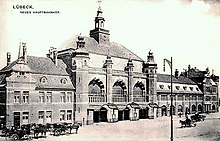Fritz Klingholz
Friedrich Kling wood , known as Fritz Kling wood (* 21st October 1861 in Barmen (today a part of Wuppertal ); † 23. January 1921 in Berlin ) was a German architect , construction officer, Mr and university teachers , which refers to the construction of the station - reception buildings dedicated would have.
Family and social environment
Fritz Klingholz came from a merchant family that had lived in Rittershausen am Klingholzberg since the 16th century . Fritz Klingholz married Anna Melitta Noak, daughter of a Berlin furniture manufacturer, in April 1911. The only son - he also had the name Friedrich - was born in March 1913.
His circle of friends in Berlin included numerous artists, including Georg Kolbe , August Gaul , Franz Iffland , Heinrich Zille and the illustrator Gertrude Korth .
Career
education
First he attended secondary school in Barmen, after moving to Bonn . After graduating from high school in Cologne , Klingholz studied at the Technical University of Stuttgart from 1880 to 1882 and at the Technical University of Charlottenburg from 1882 to 1884 . There he passed the first state examination as a master builder. In 1886 he entered the Prussian civil service and was initially concerned with the redesign of railway systems in Düsseldorf . In May 1889 he fell from a scaffolding and smashed his right elbow joint , which stiffened. Klingholz returned to Berlin in 1891 and passed the second state examination as a master builder with distinction the following year. He then went on a study trip to Tuscany for three months .
Professional activities
From 1893 to 1904 he worked as a government master builder ( Assessor ) in the Prussian Ministry of Public Works with drafts for railway structures. The first three years in the ministry was Kling wood as Deputy Director of Construction for the Imperial Government of German East Africa drafted where he was responsible for the construction of the railway station of Dar es Salaam and the renovation of the city. He used this stay to then undertake a six-month study visit to British India , where he visited Bombay , Delhi , Agra , Benares , Ahmedabad and Jaipur .
In 1902 he received the title of " Royal Agricultural Inspector ". In 1904 he became head of building construction at the Mainz Railway Directorate , and in 1905 he switched to the Technical University of Aachen , where he was also responsible for Renaissance research. In 1908 he was appointed professor at the Technical University of Hanover and in 1911 at the Technical University of Charlottenburg. Here he received the title of " Privy Councilor ". Despite being disabled, he was drafted into World War I in 1915 , but then released early as a first lieutenant in 1917 for health reasons . In 1920 he was awarded an honorary doctorate from RWTH Aachen University for his services .
As a rule, he did not work alone on his railway constructions, but worked together with other architects. In addition to building railways, he also built villas for private clients and himself. He took part in numerous competitions.
Work (selection)
Station entrance building
- Ebersstrasse station of the Berlin Ringbahn (commissioned in 1897), today: Schöneberg S-Bahn station
- Pulitzstrasse station of the Berliner Ringbahn (commissioned in 1897), today: Westhafen S-Bahn station (in the period 1896–1899)
- Koblenz Central Station (1899–1902)
- Essen Central Station (1900–1902, destroyed in World War II)
- Sadowa station, today: Berlin Wuhlheide station (in the period 1896–1899)
- Extension for the Szczecin train station (1903), demolished in 1962
- Worms main station (opened in 1904)
- Wiesbaden Central Station (1904–1906)
- Bad Kreuznach station (opened in 1905)
- New Lübeck Central Station for the Lübeck-Büchener Railway (commissioned in 1908)
- Lübeck-Travemünde Strand station for the Lübeck-Büchener Railway (commissioned in 1912)
- Berlin-Lichtenberg train station (collaboration)
drafts
- Berlin-Grunewald train station (1899)
- Hamburg Central Station (1901)
- Metz main station (1905) - 2nd prize
- Leipzig main station (1907) - 2nd prize
- Darmstadt main station (1907) - 2nd prize (together with Friedrich Pützer )
- Völkerschlachtdenkmal , Leipzig
Others
Since December 2007, the new Klingholzstrasse near Wiesbaden Central Station has borne the architect's name.
literature
- Building construction drafts of the Royal Technical University of Aachen, made under the direction of Professor Fritz Klingholz. Berlin 1908.
- Friedrich Klingholz [ grandson ]: Fritz Klingholz - a German train station architect at the turn of the 19th to the 20th century . In: Yearbook for Railway History 43 (2011/2012), pp. 99-108.
- Robert Malcher: The station buildings by Fritz Klingholz. Diploma thesis in architecture at the Technical University of Berlin . Berlin 2006. ( online, PDF )
Web links
- Fritz Klingholz at www.klingholz-fritz.de , last accessed on November 11, 2010
- Klingholz drafts in the Architekturmuseum der TU Berlin , last accessed on December 10, 2010
| personal data | |
|---|---|
| SURNAME | Klingholz, Fritz |
| ALTERNATIVE NAMES | Klingholz, Friedrich |
| BRIEF DESCRIPTION | German architect, Prussian building officer and university professor |
| DATE OF BIRTH | October 21, 1861 |
| PLACE OF BIRTH | Barmen |
| DATE OF DEATH | January 23, 1921 |
| Place of death | Berlin |





